Ever had a dog who won’t give you his bone or chew toy if you try to take it from him? Or one who gets uncomfortable or growls if you get close to him when he’s eating his dog food? Or snaps at you if he’s on the sofa and you want him off? Or lifts his lip in a snarl if your friend tries to get close to you?
Answer yes to any of the above, and you’ve successfully diagnosed your dog as having a guarding issue. The catch-all, technical term is “resource-guarding,” and can include guarding of dog food bowls (or food), places (dog crate, dog bed, sofa, etc.), items (rawhide, bones, balls, tissues, etc.) and less commonly, people.
Resource-guarding simply means that a dog gets uncomfortable when we (or other humans) are around him when he has “his stuff.” He’s nervous that we’re going to take it away, so he tries to warn us off in a variety of ways, ranging from simply consuming his food faster, to an all-out bite.
Although canine resource-guarding appears to be more prevalent in certain breeds or classes of dogs, it can appear in literally any dog, including that sweet Papillion that lives down the street, or the goofy Golden Retriever who greets you happily on your morning walks.
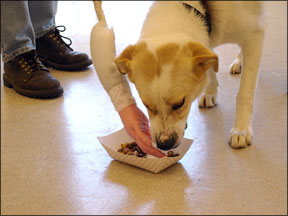
288
It’s important to recognize, identify, modify, or at least manage this behavior because a dog who is repeatedly pushed or punished in these situations is highly likely to eventually bite. Sure, it might be you that he bites, but it could also be your child, your neighbor’s child, your boss, or your grandmother. Children are most apt to be at risk for a number of reasons. They tend to disregard warnings to “leave the dog alone” when he’s eating or has a toy; they frequently fail to notice the dog’s warning signs (stiffening, growling); and they are closer to the ground, so if the dog decides to bite, most likely the child’s face will bear the brunt of the attack.
Nature or nurture?
Resource-guarding “is a perfectly normal survival skill that allows smaller, weaker, and lower-status dogs to keep possession of a highly valued object even when that object is the target of a larger and stronger dog’s desire,” says Pat Miller, a trainer, Certified Dog Behavior Consultant, and Whole Dog Journal Training Editor. In her book, The Power of Positive Dog Training, Miller notes that, “Natural behavior or not, resource-guarding is a serious problem when it results in open aggression, especially toward humans.”
In the wild, “a group-hunting carnivore would have reproductive advantage over one who gladly relinquishes. It’s a good trait, like a well-developed immune system or legs that can run fast,” says canine behavior expert Jean Donaldson, in her highly educational book, Mine! (devoted solely to the topic of resource-guarding). Of course, she adds, “In a domestic environment, it is undesired.”
Sarah Kalnajs, trainer and Certified Dog Behavior Consultant, describes resource-guarding as having both nature (genetic) and nurture (upbringing) components. A dog might be genetically inclined to guard, but depending how much he is allowed to practice the behavior throughout his life also contributes to the severity of the problem.
Resource-guarding from other dogs is a much more “acceptable” or natural behavior in terms of a dog’s ability to cohabitate with humans. It can certainly lead to big problems, and should not be dismissed, but for the time being, our discussion will focus on guarding from humans. Note: A dog who guards from other dogs will not necessarily resource-guard from humans.
What’s your type?
“Food-guarding” seems to be the most common kind of canine guarding behavior, and is present if the dog “threatens” or bites when:
-Approached while eating from his bowl
-The owner tries to take back a food item the dog has grabbed
-Approached after he finds some kind of food item in the gutter or on the street
“Some dogs may be compulsive, guarding all food items and even an empty dish,” says Donaldson, but she also notes, “The majority will guard only when actually in possession of sufficiently motivating food.” The fact that a dog does not guard a particular food (say, a Milk Bone) does not rule him out as a guarder. It just might not be worthy enough to him as, say, a chicken wing. The only way to determine whether a dog will guard a particular highly motivating food item is to test whether you can readily take that item when the dog has it.
With “object-guarding,” the extent of guarding is dependent upon the value of the object to the dog. Items can include, but are certainly not limited to, bones, rawhides, pig ears, favorite toys/balls, laundry items, tissues, wrappers and other garbage, sticks, and/or any “forbidden” objects the dog happens to pick up – which are made more valuable by extreme owner reaction, such as chasing the dog around the room to get the item back, or screeching at the dog to give the item up. While some trainers classify bones, rawhides, pig ears, and edible garbage as “objects,” Pat Miller classifies them as food as the dog’s intent is to eat them; therefore, she classifies the dog’s behavior as food-guarding.
As with food-guarding, the dog may show signs of guarding simply when a person is in the vicinity, as the person approaches, and/or if the person tries to take the object from him. It is very common that a dog won’t want something unless you want it. “Location-guarding” is also common in modern, dog-loving households. This would describe the following:
-A dog who does not allow owner or spouse into the bedroom or on the bed once the dog is on the bed
-A dog who is grumpy if jostled while on furniture, or when someone tries to move him
-A dog who threatens passersby while he’s in his crate, car, or favorite rest spot
The severity of resource-guarding depends upon the value of the item, and who is approaching. In the case of location-guarding, the dog might allow “the wife” on the bed, but not her husband.
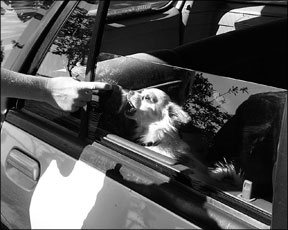
288
“Owner-guarding” seems to occur fairly frequently when other dogs are present. Occasionally, however, the dog will guard his person if the dog is on leash with the person, or near her. Some people interpret this as “protectiveness.”
Pat Miller differentiates these behaviors. “A good ‘protection’ dog recognizes a legitimate threat to his person and acts to deter the threat, or waits for instructions from the human to act. A dog who is ‘guarding’ his person – in the sense of resource-guarding – covets his owner as a possession that he’s not willing to share with other dogs, or sometimes other humans. He sees the approaching dog/person as a threat to his enjoyment of his resource, rather than a physical threat to the person.”
Owner-guarding can also become somewhat muddied if the owner has in his possession some resource – food or a bone, for example – that is valuable to the dog. He may react if his human carries treats or a bait bag. In this case, what, really, is the dog guarding: item or owner?
Trainer Virginia Broitman notes that many dogs who guard their owners are actually very insecure, and might feel empowered to act out because their humans are there. Or, the dog is on leash and cannot escape, so he resorts to an impressive display to keep the stranger away. Were he without his handler, or not on leash, we might see a different reaction.
Stay positive
You’ve shouted “No!” You’ve stomped your foot. You’ve used a physical correction. But your dog still freezes and growls when you get near him when he’s eating or when he has his “stuff.” What can you do?
First, you need to understand that shouting, stomping, and using physical corrections on the dog will only make matters worse.
I recently saw video footage of a trainer working with a large, young dog who had a history of guarding his food bowl. Over time, the owners had tried a variety of approaches: yelling at the dog, leaning over him while he ate and yelling, hand feeding, and petting the dog while he ate. Unfortunately, the owner reported that the dog had become reactive to the owner when the owner was at a greater and greater distance from the guarded food. And when the owner tried “dominance” — in which he stood over the dog while the dog ate and “made” him do things for his food, then physically reprimanded the dog for being aggressive – the owner got bitten.
While the footage was stellar – the camera caught all of the dog’s warnings superbly – the method that the trainer recommended for dealing with the problem was not. Instead of using behavior modification, which has the potential to make the dog safe around anyone, the trainer elected to use force and physical corrections using a choke chain to “show the dog that the people were in charge.”
The trainer advised the couple to approach the bowl with the dog on leash and physically correct the dog for lunging toward the bowl or showing any signs of aggression (guarding), then “make” the dog sit about a foot away from the food. Once the dog was “calm,” he was allowed to eat, remaining on leash with the owner. If the dog showed any aggression, the handler was to physically correct the dog and yank him away from the food bowl, wait for the dog to “calm down,” then start again.
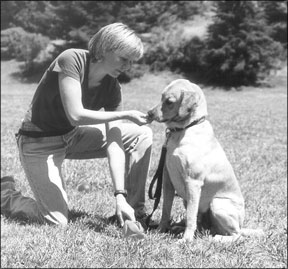
288
There are several problems with this approach. First, the couple hoped to one day have children, and this “method” taught the dog nothing about interacting with someone who didn’t have a leash and the strength to make a physical correction. In addition, the trainer repeatedly triggered a reaction from the dog. Behavior experts agree that, in contrast to the approach used in the video, successful behavior modification works at a sub-threshold level, at a low-enough level of intensity to prevent the dog from reacting. Also, the trainer also did nothing to address the dog’s emotional state (nervous, insecure, and stressed) and instead intensified it; what was defined as “calm” was anything but.
It’s possible to suppress guarding behavior using force, says Pat Miller. “However, you haven’t changed the dog’s emotional response to a threat to his resource, just his physical response. It’s quite possible that the guarding behavior will return if and when he feels too threatened, or is approached by someone that he doesn’t perceive as capable of overpowering his desire for his resource.
“Any time you use force, you risk escalating the level of violence rather than modifying the behavior. You may not know until you’ve done significant behavioral damage that your dog is one who escalates, rather than shuts down, in the presence of violence.”
Here’s another dire scenario: If your dog growls at you over his food bowl and you punish or challenge him in some way, it might very well occur to him that his growl wasn’t sufficient to warn you off. He may resort to the next warning level – a snarl, snap, or worse – in an effort to more effectively protect his food.
Behavior modification:
Get to the problem’s root
Experts agree that the best route to take in dealing with resource-guarding is to use a combination of management and behavior modification.
Essentially, “management” entails intervening in (or anticipating and preventing) a situation so that the dog cannot repeat inappropriate behavior. For example, we keep food and toys picked up around a resource-guarder so that he cannot engage in guarding. Management does not necessarily or teach the dog anything; he simply has less opportunity to practice an undesirable behavior.
The most important tools in the behavior-modification toolbox, though, are systematic desensitization and counter-conditioning.
Desensitization involves exposing the dog to whatever it is that previously evoked his fear or anxiety, but at a distance and intensity that does not produce a response.
Counter-conditioning is a process in which we replace a dog’s involuntary, undesirable reaction (such as fear) with a more desirable response – one that is incompatible with the undesirable old response (such as the eager anticipation of a tasty treat). We create a positive emotional response by associating an event (your approach) with something good (a reward). This methodology has been proven to work, and is relatively easy and pleasant for both human and dog.
With counter-conditioning, you don’t exert your “control” over the dog in any way, but instead, transform your presence around the dog’s possessions into a signal that even better things are coming. One event becomes a reliable predictor of another event, and the subject develops an anticipatory response to the first event. By pairing good things (extra scrumptious treats) with the formerly bad thing (your approach or presence near whatever he is guarding), your proximity starts to become a better thing – a predictor of what is to come (treats!).
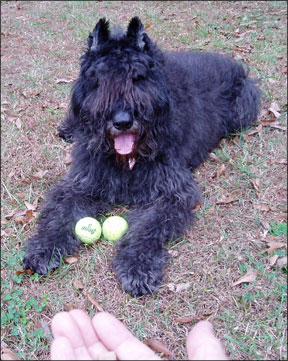
288
The goal is to transform a food-guarder who becomes tense or upset when a person approaches him while he’s eating into a dog who is happy to be approached while eating, as this reliably predicts the delivery of even more food or treats.
Donaldson stresses the need to work at a low threshold; if at any point the dog shows the original reaction, you have gone super-threshold, and it is necessary to back up and start at a point where the dog does not react. “No good comes of rehearsing the dog’s old, growly behavior by replicating super-threshold versions of the trigger. In fact, it can make the dog worse.”
Donaldson also makes it clear that when working with a guarder, we need to be sure that the first event (the “threat” to the resource) must come before the delivery of the counter-conditioning treat. For example, in a food bowl exercise, “the approach, bowl touch, or bowl removal must precede the addition of bonuses to the dish.” This means that we do not, for example, show a dog the bait in hopes of preventing a guarding reaction. Doing so will not condition the appropriate emotional response.
Doing the work
Ideally, you start with a young pup who doesn’t guard and teach him early on that your presence predicts good stuff, says Miller. “You do this by offering to trade something wonderful for whatever he already has – such as a toy of moderate value, to start with – working your way up to really high-value items. I teach a ‘Give’ cue by saying ‘Give,’ then offering a high value treat in exchange for his object. Repeat until he will happily give up any object when you ask him to ‘Give.’ ”
Trainers use different protocols; there is always more than one way to approach an exercise. The protocol you use should be tailored to your dog, depending on the seriousness of his guarding behavior. “Progress gradually to the next step, only when your dog is totally relaxed at the current step,” says trainer Virginia Broitman. “Some dogs will move quickly through the steps, while others may need weeks of work. Don’t rush! If at any point you are concerned for your safety or unclear on any step, discontinue the exercises and consult an experienced trainer/behavior counselor for personalized assistance.”
One example of a protocol for a dog who already guards objects begins with a good look at all the items in the dog’s environment and ranking them according to their value to the dog. For instance, a ball may be a low-value item, while a rawhide may be extremely high-value. A list might look like this:
• Stuffed squeaky toys
• Latex squeaky toys
• Rubbery flying disks
• Pig’s ears
• Rawhide chews
• Rope toys
• Balls
• Socks
• Newspapers and magazines
Once the items have been ranked, training begins with the items that the dog doesn’t especially care about and does not want. Initially, higher value items must not be available to the dog, because we want to prevent him from “practicing” his guarding behavior.
A session begins with the trainer presenting a low-value item to the dog and telling him to “Take it!” Almost immediately, the trainer gives a cue for “Drop it!” and gives the dog an extremely delicious treat.” The idea is that the dog is more than happy to “drop” the low-value item in favor of the treat. This exercise would be repeated dozens of times over a number of sessions.
Note: If the trainer is concerned that the dog may act aggressively in order to take the higher-value treat, she should have the dog on a tether, position herself just out of reach, and toss the treats in such a way to most safely reach for the low-value item. Again, in the case of a dog whose guarding behavior rates higher than a four on the scale found on page 5, the services of a qualified, positive canine behavior professional are recommended.
Only when the dog is comfortable with the first step would the protocol change, first by giving the dog the item and walking away, giving him a minute to enjoy the low-value item, and then returning to trade. As long as the dog continues to respond well to these exercises, you would work up to the more valuable items higher on your dog’s list. Training would occur in a variety of locations, and from then on, throughout the dog’s life, “spot checks” would be instituted to be sure that the dog retained what he learned.
Note: This example is a summary provided only to give the reader an idea as to what is involved in rehabilitating a guarder. If you have a guarder, you will need to follow a more detailed, structured protocol, and may require the assistance of a qualified behavior professional. See “Finding the Right Trainer,” below.
If your household includes children, you will need to take special precautions. Initially, only the adults should work with a dog who guards; kids should be a part of the guarding-rehabilitation program only after the adults have worked extensively with the dog, and only under direct supervision of an adult. Never assume that once your dog stops guarding with you, that he’ll stop guarding his items from the kids.
Similarly, you should never assume that once your dog no longer guards his cherished items from you or your family, he will no longer guard them from other people. Plan, manage, and supervise your dog’s interactions carefully, to prevent any possible harm to other people.
For location-guarding, follow a similar protocol. Start by using a place the dog does not guard and reward him for coming away from/off the place willingly. Donaldson likes to use target training as part of this protocol.
Manage in the mean time
Guarding behavior can be a daunting challenge to overcome, especially if it has progressed significantly. In this case, you must find an experienced trainer/behaviorist with whom to work. Until you are able to get help, management is a valid alternative. This involves avoiding the problem or trigger through environmental control. For example, if your dog guards pig ears, remove them from your home and do not allow him access to them. Keep the bedroom door closed to a bed-guarder.
If there is a “management failure,” and the dog gets on the bed, you can either ignore the dog and wait for him to come off the bed on his own, or, more proactively, redirect him to an alternative activity, such as calling the dog to the kitchen for a cookie or inviting him out for a brief walk.
If your food-guarder ever manages to pick up something that’s dangerous (such as a bar of dark chocolate) or valuable to you (like your prescription glasses), Donaldson advises trying a quick, calm, “bait and switch.” Bribe or distract the dog with anything you can think of. “Although bribery is totally ineffective for fostering actual behavior change, when you’re in a jam, anything goes,” she says. But remember, repeated management failures teach the dog nothing.
Rehabilitation of a resource-guarder takes time and requires patience. But the payoff in the end – for you, your dog, and your friends and family – is well worth the effort.
Lisa Rodier became interested in guarding behaviors through her volunteer work in shelters and Bouvier rescue. She lives in Alpharetta, Georgia, with her husband and two Bouviers, and serves on the Board of Advisors for Service Dogs of Virginia, Inc.


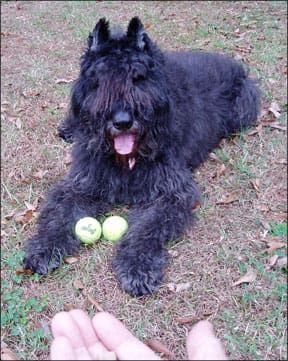
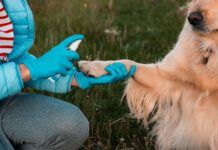
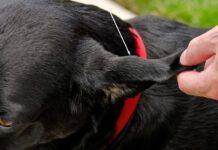
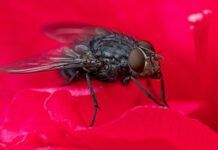
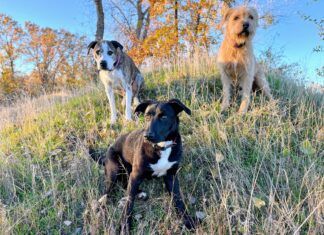
This article alludes to “owner guarding” from other dogs etc, due to insecurities, but doesn’t explain how to address the problem… goes back to food and toy guarding from humans or animals, which seems to be a separate issue from a dog keeping other pets from “its human”.